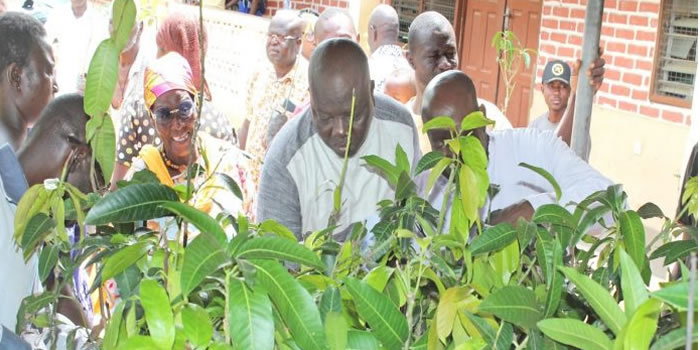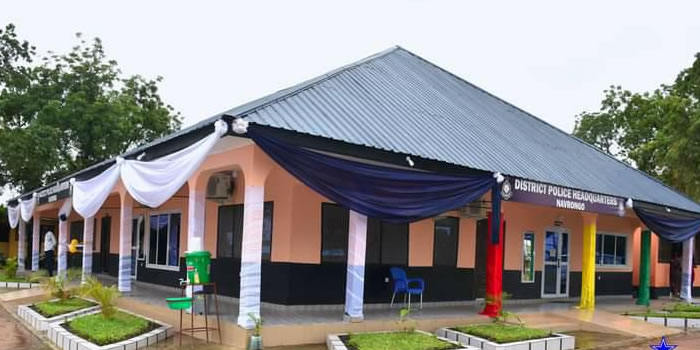

List Of Project
Others
1. Construction of Pavilion at ¢48,917,793.00
2. Rehabilitation of Bungalows at ¢48,480,921.00
3. Supply of furniture by the Central Bank
Local Government
- Completion of 32 market stores and facilities at ¢304,070,202.00
- Construction of 10-unit Garage for the District Assembly at ¢24,226,000.00
- Rehabilitation of 2 Bungalows at ¢45,682,985.00
- Under construction of 3-storey building, Peace Corps Quarters and Installation of inter com at ¢362,372,152.00
Goals And Objectives
Development Focus, Goals, Objectives And Strategies
The development focus of the Kassena-Nankana Municipal is to ensure improvement in the quality of life of all the people in the Municipality by providing basic socio-economic services such as health care, quality education, potable water, ensuring food security and the creation of an enabling environment for private sector participation and sustainable development.
Development Goal
The Kassena-Nankana Municipal Assembly in its MTDP under the GPRS-II (2006-2009) has set itself to increase private sector participation in the socio-economic development, provision of basic infrastructure and to alleviate poverty, by raising agriculture production, creating more employment so as to increase income levels and ultimately raising the living standards of the people.
Broad Objectives
Objective 1: To promote private sector participation in the development of the Objective 2: To provide basic socio-economic infrastructure in the Objective 3: To improve upon the logistic and human resources in the Objective To ensure clean, safe and healthy environment in the Objective 5: To promote economic activities in the Municipality especially for the vulnerable and excluded Objective 6: To facilitate the development of information and technology base in the Objective 7: To enhance good governance by strengthening the administrative set-up of the Assembly. Objective 8: To ensure efficient and effective revenue mobilization and management.
Thematic Area: Private Sector Competitiveness
Programme Area: Agriculture
GOAL: To increase agricultural production and income of farmers
Thematic Area: Private Sector Competitiveness
Programme Area: Drylands
GOAL: Ensure sustainable development by protecting the environment
Thematic Area: Private Sector Competitiveness
Programme Area: Industrial Development
Goal: Promote Industrial Development
Thematic Area: Private Sector Competitiveness
Programme Area: Tourism
Goal: To promote tourism industry in the municipality
Thematic Area: Private Sector Competitiveness
Programme Area: Transport (Road)
Goal: To improve r road network in the municipality
Thematic Area: Human Resource Development And Basic Services
Programme Area: EDUCATION
GOAL: Improve quality of teaching and learning for enhanced pupils achievements
Thematic Area: Human Resource Development And Basic Services
Programme Area: Health Care
Goal: To improve the quality and accessibility to health delivery services in the Municipality.
Thematic Area: Human Resource Development And Basic Services
Programme Area: Health Insurance
Goal: Making health care services affordable and accessible to all residents
Thematic Area: Human Resource Development And Basic Services
Programme Area: HIV/AIDS
Goal: Efficient management of the spread of HIV/AIDS, infected and affected people within the municipality.
Thematic Area: Human Resource Development And Basic Services
Programme Area: Water And Sanitation
Goal: Increase access to safe water supply and sanitation facilities.
Thematic Area: Human Resource Development And Basic Services
Programme Area: Population Management
Thematic Area: Human Resource Development And Basic Services
Programme Area: Special Programmes For The Vulnerable And Excluded
Goal: To provide adequate support for the Vulnerable and Excluded
Thematic Area: Human Resource Development And Basic Services
Programme Area: Entrepreneurial Development
Goal: Enhance entrepreneurial skills of the youth
Thematic Area: Good Governance and Civic Responsibility
Programme Area: Decentralization
Goal: To create an enabling environment for development
Thematic Area: Good Governance and Civic Responsibility
Programme Area: revenue Mobilization
Goal: To widen and increase the level of revenue mobilization in the district.
Thematic Area: Good Governance and Civic Responsibility
Programme Area: Gender
Goal: To widen and increase the level of women participation in socio-economic and political development the Municipality.
Monitoring is a process, which ensures that, at any given stage of a project, the required inputs are delivered on time, used as intended and is producing the desired results.
Since plans are affected by uncontrollable situations such as:
- Socio-economic changes
- Political climate
- International relations,
It is necessary that they are constantly monitored and adjustments made accordingly. The monitoring scheme is designed for the annual plan. In the scheme, three (3) activities occur:
1. Monitoring activities cover the implementation period.
2. On-going evaluation occurs at specific points within the implementation phase.
3. Terminal evaluation occurs at specific end of the project implementation.
The Monitoring Report
Project monitoring formally starts when the actual implementation of project begins. Monitoring is therefore directed at ensuring that the progress of the project proceeds according to schedule that the quality of work is up to standard, and that all inputs (including labour) are on site at the appropriate time, in the right quantity and of right quality.
Programme and Project Monitoring Report Format
(i) Project Identification………………………………………………………
(ii) Project Title………………………………………………………………..
(iii) Project Code No……………………………………………………………
(iv) Project Location……………………………………………………………
(v) Implementing Agency (ies)………………………………………………..
(vi) Monitoring Team…………………………………………………………..
(vii) Date of Monitoring…………………………………………………………
Evaluation
To determine whether results (Positive or Negative) have been achieved, the causes of deviation, if any, and how to counteract any unintended consequences, evaluation processes are undertaken. The main purpose for evaluation is to give feedback, which can lead to replanning.
Evaluation Report
Evaluation is conducted in greater details at the project level. Ex-post evaluation is conducted in order to find out whether the resources invested have produced or are producing the expected level of output and benefits and whether the benefits are reaching the intended target population. The first Ex-post evaluation should be conducted one year after completion of the project when the impact of the project should be evident.
The evaluation report is prepared in accordance with the following format.
Programme/Project Identification
(ii) Project Title……………………………………………………………….
(iii) Project Code No…………………………………………………………..
(iv) Project Location…………………………………………………………..
(v) Implementation Agency (ies)…………………………………………….
(vi) Evaluation Agency (ies)/ Team…………………………………………..
(vii) Date of Evaluation………………………………………………………..
Evaluation Topics
Objectives
- Have the Programme/Project objectives been achieved?
- Are the Programme/Project objectives still relevant?
- Has the Programme/Project supported the policy (ies) as planned? Where the Programme/Project have not been achieved give reasons
- State any policies, which need adjustment and give reasons for those objectives, which are shown to be no longer relevant as a result of the evaluation.
Time and Finance
1. Was the Project completed in the time planned? If not, state the length of over-run.
2. Was the Project cost within the amount estimated? If not state amount of over or under expenditure.
3. Did the funds come on-stream as planned and anticipated? If not what shortfalls occurred.
4. Are recurrent costs within the planned level? If not state over expenditure.
5. Where over-runs, over-expenditure and funding shortfalls have occurred give reasons in full and state how theses
events can be avoided in future.
Are the benefits reaching the targeted beneficiaries? If not state beneficiaries not being reached
- Are the benefits at the planned quantitative and qualitative levels? If not state shortfalls
- Are revenues at the planned level? If not state shortfalls (for programmes and projects designed to be revenue earning only).
- Where planned targets in terms of benefits and beneficiaries have not been achieved, give reasons in full and state how the situation will be avoided in future.
Operations
1. Is the project operating at the planned level? If not state deficiency.
2. Are the programme/project assets being properly maintained? If not state causes for failure.
Thematic Area Indicators
Private Sector Competitiveness
- Agriculture
- Average land sizes under cultivation.
- Annual growth rate in primary production.
Environment
1. Frequency of tree planting exercises.
2. Reported cases of bush fires.
3. No. of fire volunteers per trained year.
Feeder roads
- Number of feeder roads to rural producing centres upgraded.
- Number of steel bridges.
Tourism
1. Tourism infrastructure.
2. Type of personnel for the Tourism sector
ICT
- Number of ICT infrastructure.
- Electricity coverage.
industrial Development
- Annual growth rate in industrial enterprises.
Human Resource Development
Education
1. Pupil/Teacher ratio.
2. Pupil/Classroom ratio.
3. Basic school enrolment rate.
4. Performance at BECE and SSCE.
5. Number of schools with functioning services.
Health
- Doctor/Population ratio.
- Nurse/Patient ratio.
- Maternal and general mortality rate.
- Threshold of reported diseases at OPD.
- Infant and child survival rate.
HIV/AIDS
1. Rate of prevalence.
2. Number of reported cases.
3. Patronage level of contraceptives.
4. Number of people who lose their jobs because of the virus and subsequent death per year.
5. Level of stigmatisation.
Special Programmes for the Vulnerable and Excluded
- Reported violence against women.
- Reported cases of bad cultural practices.
- Number of CWD informal schools and PWDs with employable skills fully employed.
Population Management
1. Fertility rate.
2. Percentage of family planning acceptors.
Water and Sanitation
- Number of unprotected drinking sources.
- Percentage of population with access to potable water.
- Level of waste management.
- Percentage of population with access to toilet facilities.
Skills and Entrepreneurial Development
1. Number of people with employable skills.
2. Average intake into trade institutions.
3. Number of graduants from youth development centres.
4. Number of people absorbed into the Youth and Employment Programme.
Good Governance
- Increase in growth rate of Assembly revenue mobilization.
- Operational capacity of institutions.
- NGOs share of funds and contribution.
- Rate of haphazard physical development.
- Rate of environmental degradation.
- Conflict/Litigation level.
Date Created : 11/21/2017 12:32:33 AM











 facebook
facebook
 twitter
twitter
 Youtube
Youtube
 +233 593 831 280
+233 593 831 280 0800 430 430
0800 430 430 GPS: GE-231-4383
GPS: GE-231-4383 info@ghanadistricts.com
info@ghanadistricts.com Box GP1044, Accra, Ghana
Box GP1044, Accra, Ghana